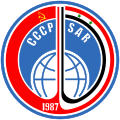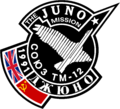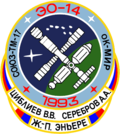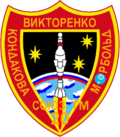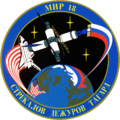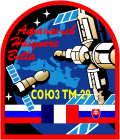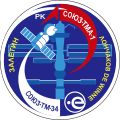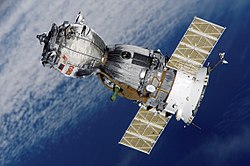Soyuz 7K (1966–1981)
The first Soyuz series was the 7K series.
| No. | Mission | Spacecraft | Date of launch | Date of landing | Crew (launch/landing) | Docking | Outcome |
|---|---|---|---|---|---|---|---|
| — | Kosmos 133 | Soyuz 7K-OK (A) 11F615 #2 [1] | 28 November 1966 | 30 November 1966 | None [2] | Soyuz 7K-OK No.1 — Cancelled due to the postponement of the launch of the 2nd ship | Partial |
| — | Soyuz 7K-OK No.1 | Soyuz 7K-OK (P) 11F615 #1 [3] | 14 December 1966 | N/A | None (rocket exploded on launch pad) | Kosmos 133 — Cancelled | Failure |
| — | Kosmos 140 | Soyuz 7K-OK (P) 11F615 #3 | 7 February 1967 | 11 February 1967 | None | Success | |
| 1 | Soyuz 1 | Soyuz 7K-OK (A) 11F615 #4 | 23 April 1967 | 24 April 1967 | | Soyuz 2A — Docking (and launch of the 2nd ship) has been cancelled due to the failure of Soyuz 1 | Failure |
| — | Kosmos 186 | Soyuz 7K-OK (A) 11F615 #6 | 27 October 1967 | 31 October 1967 | None | Kosmos 188 | Success |
| — | Kosmos 188 | Soyuz 7K-OK (P) 11F615 #5 | 30 October 1967 | 2 November 1967 | None | Kosmos 186 | Success |
| — | Kosmos 212 | Soyuz 7K-OK (A) 11F615 #8 | 14 April 1968 | 19 April 1968 | None | Kosmos 213 | Success |
| — | Kosmos 213 | Soyuz 7K-OK (P) 11F615 #7 | 15 April 1968 | 20 April 1968 | None | Kosmos 212 | Success |
| — | Kosmos 238 | Soyuz 7K-OK 11F615 #9 | 28 August 1968 | 1 September 1968 | None | Success | |
| — | Soyuz 2 | Soyuz 7K-OK (P) 11F615 #11 | 25 October 1968 | 28 October 1968 | None | Soyuz 3 — Docking failed due to errors in spacecraft orientation | Partial |
| 2 | Soyuz 3  | Soyuz 7K-OK (A) 11F615 #10 | 26 October 1968 | 30 October 1968 | | Soyuz 2 — Docking failed due to errors in spacecraft orientation | Partial |
| 3 | Soyuz 4  | Soyuz 7K-OK (A) 11F615 #12 | 14 January 1969 | 17 January 1969 | | Soyuz 5 | Success |
| | |||||||
| 4 | Soyuz 5  | Soyuz 7K-OK (P) 11F615 #13 | 15 January 1969 | 18 January 1969 | | Soyuz 4 | Success |
| | |||||||
| 5 | Soyuz 6 | Soyuz 7K-OK 11F615 #14 | 11 October 1969 | 16 October 1969 | | The crew should have taken pictures of the docking between Soyuz 7 and Soyuz 8, but it wasn't possible | Partial |
| 6 | Soyuz 7 | Soyuz 7K-OK (A) 11F615 #15 | 12 October 1969 | 17 October 1969 | | Soyuz 8 — Failed due to the failure of rendezvous electronics | Partial |
| 7 | Soyuz 8 | Soyuz 7K-OK (P) 11F615 #16 | 13 October 1969 | 18 October 1969 | | Soyuz 7 — Failed due to the failure of rendezvous electronics | Partial |
| 8 | Soyuz 9  | Soyuz 7K-OK 11F615 #17 | 1 June 1970 | 19 June 1970 | | Success | |
| 9 | Soyuz 10 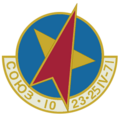 | Soyuz 7K-OKS 11F615A8 #31 | 23 April 1971 | 25 April 1971 | | Salyut 1 — Docking failed due to a docking system failure | Failure |
| 10 | Soyuz 11  | Soyuz 7K-OKS 11F615A8 #32 | 6 June 1971 | 30 June 1971 | (Crew died during reentry due to depressurization of landing module) | Salyut 1 | Failure |
| — | Kosmos 496 | Soyuz 7K-T 11F615A8 #33A | 26 June 1972 | 2 July 1972 | None | Success | |
| — | Kosmos 573 | Soyuz 7K-T 11F615A8 #36 | 15 June 1973 | 17 June 1973 | None | Success | |
| 11 | Soyuz 12 | Soyuz 7K-T 11F615A8 #37 | 27 September 1973 | 29 September 1973 | | Success | |
| — | Kosmos 613 | Soyuz 7K-T 11F615A8 #34A | 30 November 1973 | 29 January 1974 | None | Success | |
| 12 | Soyuz 13  | Soyuz 7K-T 11F615A8 #33 | 18 December 1973 | 26 December 1973 | | Success | |
| — | Kosmos 638 | Soyuz 7K-TM 11F615A12 #71 | 3 April 1974 | 13 April 1974 | None | Success | |
| — | Kosmos 656 | Soyuz 7K-T/A9 11F615A9 #61 | 27 May 1974 | 29 May 1974 | None | Success | |
| 13 | Soyuz 14  | Soyuz 7K-T/A9 11F615A9 #62 | 3 July 1974 | 19 July 1974 | | Salyut 3 | Success |
| — | Kosmos 672 | Soyuz 7K-TM 11F615A12 #72 | 12 August 1974 | 18 August 1974 | None | Success | |
| 14 | Soyuz 15 | Soyuz 7K-T/A9 11F615A9 #63 | 26 August 1974 | 28 August 1974 | | Salyut 3 — Docking failed due to malfunctioning of Igla docking system | Failure |
| 15 | Soyuz 16  | Soyuz 7K-TM 11F615A12 #73 | 2 December 1974 | 8 December 1974 | | Success | |
| 16 | Soyuz 17  | Soyuz 7K-T 11F615A8 #38 | 11 January 1975 | 9 February 1975 | | Salyut 4 | Success |
| 17 | Soyuz 18A | Soyuz 7K-T 11F615A8 #39 | 5 April 1975 | 5 April 1975 | (Aborted launch at T+295 seconds;crewsurvived butexperienced 21 G's during descent) | Failure | |
| 18 | Soyuz 18  | Soyuz 7K-T 11F615A8 #40 | 24 May 1975 | 26 July 1975 | | Salyut 4 | Success |
| 19 | Soyuz 19 | Soyuz 7K-TM 11F615A12 #75 | 15 July 1975 | 21 July 1975 | | Apollo | Success |
| — | Soyuz 20 | Soyuz 7K-T/A9 11F615A9 #64 | 17 November 1975 | 16 February 1976 | None | Salyut 4 | Success |
| 20 | Soyuz 21 | Soyuz 7K-T 11F615A8 #41 | 6 July 1976 | 24 August 1976 | | Salyut 5 | Partial |
| 21 | Soyuz 22 | Soyuz 7K-TM 11F615A12 #74 | 15 September 1976 | 23 September 1976 | | Success | |
| 22 | Soyuz 23 | Soyuz 7K-T/A9 11F615A9 #65 | 14 October 1976 | 16 October 1976 | | Salyut 5 — Docking failed due to a docking system failure | Failure |
| 23 | Soyuz 24 | Soyuz 7K-T/A9 11F615A9 #66 | 7 February 1977 | 25 February 1977 | | Salyut 5 | Success |
| 24 | Soyuz 25 | Soyuz 7K-T 11F615A8 #42 | 9 October 1977 | 11 October 1977 | | Salyut 6 — Docking failed due to a docking system failure | Failure |
| 25 | Soyuz 26 | Soyuz 7K-T 11F615A8 #43 | 10 December 1977 | 16 January 1978 | | Salyut 6 | Success |
| | |||||||
| 26 | Soyuz 27 | Soyuz 7K-T 11F615A8 #44 | 10 January 1978 | 16 March 1978 | | Salyut 6 | Success |
| | |||||||
| 27 | Soyuz 28  | Soyuz 7K-T 11F615A8 #45 | 2 March 1978 | 10 March 1978 | (The first international crew) | Salyut 6 | Success |
| 28 | Soyuz 29  | Soyuz 7K-T 11F615A8 #46 | 15 June 1978 | 3 September 1978 | | Salyut 6 | Success |
| | |||||||
| 29 | Soyuz 30  | Soyuz 7K-T/A9 11F615A9 #67 | 27 June 1978 | 5 July 1978 | | Salyut 6 | Success |
| 30 | Soyuz 31  | Soyuz 7K-T 11F615A8 #47 | 26 August 1978 | 2 November 1978 | | Salyut 6 | Success |
| | |||||||
| 31 | Soyuz 32 | Soyuz 7K-T 11F615A8 #48 | 25 February 1979 | 13 June 1979 | | Salyut 6 | Success |
| Landing without crew | |||||||
| 32 | Soyuz 33  | Soyuz 7K-T 11F615A8 #49 | 10 April 1979 | 12 April 1979 | | Salyut 6 — Docking failed due to main engine and Igla docking system failure; deorbit burn was made using the backup engine | Failure |
| 33 | Soyuz 34 | Soyuz 7K-T 11F615A8 #50 | 6 June 1979 | 19 August 1979 | Start without crew | Salyut 6 | Success |
| | |||||||
| 34 | Soyuz 35 | Soyuz 7K-T 11F615A8 #51 | 9 April 1980 | 3 June 1980 | | Salyut 6 | Success |
| | |||||||
| 35 | Soyuz 36  | Soyuz 7K-T 11F615A8 #52 | 26 May 1980 | 31 July 1980 | | Salyut 6 | Success |
| | |||||||
| 37 | Soyuz 37  | Soyuz 7K-T 11F615A8 #53 | 23 July 1980 | 11 October 1980 | | Salyut 6 | Success |
| | |||||||
| 38 | Soyuz 38  | Soyuz 7K-T 11F615A8 #54 | 18 September 1980 | 26 September 1980 | | Salyut 6 | Success |
| 41 | Soyuz 39  | Soyuz 7K-T 11F615A8 #55 | 22 March 1981 | 30 March 1981 | | Salyut 6 | Success |
| 42 | Soyuz 40  | Soyuz 7K-T 11F615A8 #56 | 14 May 1981 | 22 May 1981 | | Salyut 6 | Success |
Soyuz 7K-L1
Spacecraft designed for Soviet human circumlunar missions. Missions are included under the Zond programme.
| No. | Mission | Spacecraft | Date of launch | Date of landing | Crew (launch/landing) | Docking | Outcome |
|---|---|---|---|---|---|---|---|
| — | Kosmos 146 | Soyuz 7K-L1 | 10 March 1967 | 18 March 1967 | None | Success | |
| — | Kosmos 154 | Soyuz 7K-L1 | 8 April 1967 | 10 April 1967 | None | Failure | |
| — | Soyuz 7K-L1 No.4L | Soyuz 7K-L1 | 27 September 1967 | None (rocket failure) | Failure | ||
| — | Soyuz 7K-L1 No.5L | Soyuz 7K-L1 | 22 November 1967 | None (rocket failure) | Failure | ||
| — | Zond 4 | Soyuz 7K-L1 | 2 March 1968 | 7 March 1968 | None | Partial | |
| — | Soyuz 7K-L1 No.7L | Soyuz 7K-L1 | 22 April 1968 | None (rocket failure) | Failure | ||
| — | Soyuz 7K-L1 No.8L | Soyuz 7K-L1 | 21 July 1968 | None (rocket exploded on launch pad) | Failure | ||
| — | Zond 5 | Soyuz 7K-L1 | 14 September 1968 | 22 September 1968 | None | Success | |
| — | Zond 6 | Soyuz 7K-L1 | 10 November 1968 | 17 November 1968 | None | Partial | |
| — | Soyuz 7K-L1 No.13L | Soyuz 7K-L1 | 20 January 1969 | None (rocket failure) | Failure | ||
| — | Zond-M 1 | Soyuz 7K-L1S | 21 February 1969 | None (rocket failure) | Failure | ||
| — | Zond-M 2 | Soyuz 7K-L1S | 3 July 1969 | None (rocket failure) | Failure | ||
| — | Zond 7 | Soyuz 7K-L1 | 7 August 1969 | 14 August 1969 | None | Success | |
| — | Soyuz 7K-L1E No.1 | Soyuz 7K-L1E | 28 November 1969 | None (rocket failure) | Failure | ||
| — | Zond 8 | Soyuz 7K-L1 | 20 October 1970 | 27 October 1970 | None | Success | |
| — | Kosmos 382 | Soyuz 7K-L1E "Zond-LOK" | 2 December 1970 | In orbit | None | In orbit |
Soyuz 7K-LOK
Spacecraft designed for Soviet human lunar orbital and landing missions.
| No. | Mission | Spacecraft | Date of launch | Date of landing | Crew (launch/landing) | Docking | Outcome |
|---|---|---|---|---|---|---|---|
| — | Soyuz 7K-LOK No.1 | Soyuz 7K-LOK | 26 June 1971 | None (rocket failure) | Failure | ||
| — | Soyuz 7K-LOK No.2 | Soyuz 7K-LOK | 23 November 1972 | None (rocket failure) | Failure |



